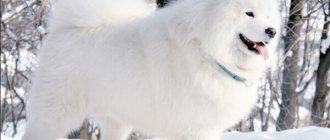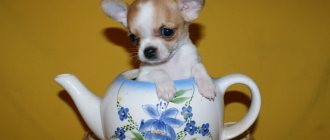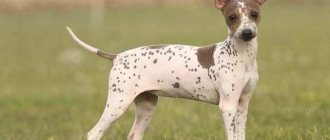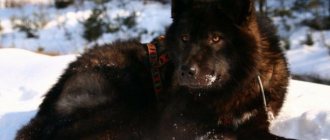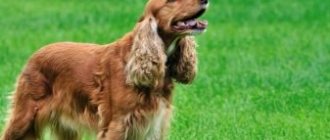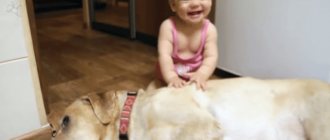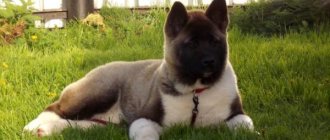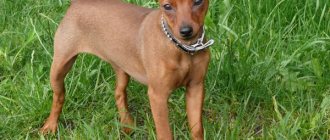The history of the Chihuahua is shrouded in mystery and mystery.
Indeed, in various countries around the world, images of dogs similar to representatives of this amazing breed were found.
Therefore, various theories about the origin of the Chihuahua are still put forward.
Where do these smallest dogs in the world come from, according to researchers, and what made them so popular today?
We'll look into this later.
Main versions of origin
Picture 2. Chihuahua breed standard
The origin of the Chihuahua is surrounded by many myths and legends. The official data that scientists and breeders have been able to collect is not enough to draw any conclusions with confidence. The collected data about the Chihuahua, where the breed came from, boils down to several main versions.
- First and main version. She adheres to information about the Toldek tribes living in Mexico. Their four-legged helpers were small dogs similar to Chihuahuas. A few centuries ago this breed was called Techichi. After some period of time, the tribes went to conquer America, taking these dogs with them. As a result of excavations on the territory of modern America, W. Web discovered a grave with the remains of more than 20 dogs. The found burial was determined to be over 3000 years old. BC e. As a result, we can conclude that these dogs lived in America even before sailors first discovered Mexico. Descendants of the Chihuahua still live in Indian tribes. They have compact sizes, white and red color, a ring tail and other similar features.
Representative of the Chihuahua breed
- Second version. It was based on the assumption that the origin of the Chihuahua breed came from the Mexican hairless dog, whose ancestors were the same Techichi. However, when considering the anatomical features of these breeds, scientists refuted the theory. The tail, paws, skull structure and fur are very different and do not bear any related resemblance.
- Third version. Some researchers who find out where the Chihuahua comes from are based on the opinion that the dogs were first bred in Malta. Indeed, there have been small dogs on this island for a long time. Their main feature was the fontanel - molera, which is also characteristic of Chihuahuas. This skull structure is not typical for other dogs.
Further popularization
The history of the Chihuahua breed was continued by a certain James Watson, who was a famous dog handler at that time and the first breeder of this breed in the United States. In May 1888, he published his recommendations regarding the care of the breed.
Already in 1890, the Book of the American Kennel Club first introduced the Chihuahua breed as a participant in dog shows. A female named Midget from Texas breeder Ryder was the first to be registered in the American Canine Society's stud book. After 20 years, 170 individuals of this breed were registered there.
The history of the mini Chihuahua breed in 1907 was continued in England, where the same stud book appeared.
In 1914, the first mention of the breed was published in the American press. 1923 was the year the Chihuahua Club of America was founded and a standard was developed. The British club was opened only in 1949. And in 1954, the breed was divided into two independent subgroups: long-haired Chihuahuas and smooth-haired ones, which were judged together in the rings. In the history of the Chihuahua breed, long-haired variations are considered more ancient.
The first official breed standard was adopted in 1934, then it was updated in 1954, and the most recent one was adopted in 1972 and has not been seriously changed.
History of the name of the breed
Most researchers of this breed tend to agree that the home country of the Chihuahua is Mexico, namely the large state of Chiahua, located not far from Texas and the states of New Mexico, but rightfully belonging to Mexico. It was here in the first half of the 19th century. Dog breeders liked dogs of this breed.
Chihuahua: description of dog breed, character
Local residents sold tiny dogs to tourists, who in turn brought them to America. The animals differed in type. They could be smooth-haired or long-haired with a variety of colors. But they all had tiny sizes, a long life expectancy and a calm character, which was especially appreciated by tourists. After all, such animals could live with a child without posing a danger.
For your information! At this time the breed did not have a name. These dogs were called "dogs of Mexico" or "dogs of Chihuahua."
The appearance of a small dog in a Taco Bell advertising campaign ensured its worldwide popularity.
Features that are considered defects
As with any breed, there are minor, minor deviations in appearance, and quite significant ones. The most common faults in Chihuahuas are pronounced pointed ears, a tail that is too short or long, an elongated body and a short neck relative to it.
Thoroughbred body defects include a sloping croup, a narrow chest, and widely or narrowly spaced limbs.
Critical deviations from the norm are: a narrow forehead and skull as a whole, a long and narrow muzzle, deep-set or excessively bulging eyes, congenital patellar luxation and malocclusion.
And because of these external defects, the dog will not be allowed into shows and exhibitions:
- A clearly open fontanel on the skull;
- Deviant behavior (cowardice, aggression, excessive activity);
- Complete absence of tail;
- Short or cropped ears;
- Very long body;
- Noticeable hair loss in short-haired dogs;
- Long, matted or flying hair in long-haired dogs;
- “Deer” silhouette (small head with elongated neck and legs);
- Strong deviation in weight (overweight and underweight).
Mexican origin theory
Toy terrier and toy chihuahua: differences, who to choose
Despite the wide variety of versions of how and when the Chihuahua was bred, the Indian theory is most widespread. According to it, small dogs first appeared on the Yutakan Peninsula. The Mayan tribes called them techichi, a breed of dog designed to protect people from evil gods.
Note! People believed that these animals entered into communication with the gods, so they were kept in local temples.
Dogs were no less popular among the Aztecs, especially rich and noble people. Animals even had personal slaves. However, after the death of the owner, they were also burned on the funeral pyre. Some historians claim that instead of living dogs, their sculptural images were used.
When Mexico was invaded by conquerors, Montezuma, his people and their four-legged pets were evacuated to the northern part of the country. It was at this time that the Chihuahua breed was finally formed, when the brought Techichi mixed with local blood.
What a Techichi dog looked like
As proof of this version, scientists cite the results of archaeological research. In places where royal palaces were previously located, the remains of dogs corresponding to the modern breed were found.
Hypothesis of the origin of the Chihuahua from the Techichi
Where did dogs come from on earth: history
The fact that Techichi is a dog breed that helped the modern representatives of Chihuahuas arise is evidenced by the most plausible version. According to her, ancient dogs had larger sizes and long hair. They first lived with the Toltec people, and were later domesticated by the Mayans.
For your information! The description of Techichi and the history of their origin can be found from rock carvings, drawings, found burials and other evidence. In the city of Cholula, where many pyramids with burials were located, rock art was discovered depicting the life of the Olmecs with small dogs.
From the 12th century The Aztecs ousted the Toltecs from the territory of modern Mexico. Their culture involved sacrifice. The victims were people and animals, in particular small dogs.
Both the Toltecs, Mayans, and Aztecs buried their owners along with their dogs. It was believed that Techichi accompanied the deceased to the afterlife, showing the way. But he had to go between two mountains, escape from the attacks of snakes and crocodiles, then cross 8 deserts plus climb the same number of mountain peaks. Next, the deceased faced a test in the form of an icy wind that threw blades and boulders. After this, the deceased sat on his dog, which carried him to the kingdom of the dead.
Ancestors of modern Chihuahuas
Beginning in 1521, the Aztec tribes were destroyed by the Spanish conquistadors. They also destroyed all cultural and religious values, including sacred dogs. However, some individuals managed to hide in the forests, where they went wild.
DNA test sheds light on Chihuahua origins
There is another version of the origin of the breed. According to it, the first dogs appeared on the island of Malta. It is located 80 km from Italy. This Mediterranean island is home to the Melita, the ancestral dog breed of the Maltese. These two breeds are similar in the presence of fontanel. Thus, more than 80% of all Chihuahua puppies are born with an area of the skull unprotected by bones.
Results of the excavations
One of the proofs that this breed has European roots is the painting of the Sistine Chapel located in the Vatican. It was painted in 1481 by the famous Italian artist S. Botticelli. The mural depicts a boy with a small dog that looks very similar to a modern Chihuahua.
Note! Work on the fresco was completed 10 years before the discovery of America. This means that Botticelli could not know what type of Techichi dogs living in Mexico and North America were.
If this assumption is correct, then dogs could have appeared on the Indian coast if the conquistadors took them from Europe during their travels. However, in 2013, scientists shed light on all these assumptions using DNA research. Thus, the bright minds of the Royal Institute of Technology, which is located in Switzerland, studied the Chihuahua breed at the molecular level.
When comparing the DNA of these dogs with Asian and European breeds, no connections were found. Accordingly, Chihuahuas could not have descended from Mexican hairless dogs. Instead, a haplotype was discovered that is similar to dogs living in Mexico before its official discovery. This means that they lived in Mexico before Europeans set foot there.
Care and maintenance
Those who have decided to get a small sociable dog are wondering: how to care for a Chihuahua? In general, dwarf dogs do not cause much trouble to their owners, as they are unpretentious in everyday life. Thanks to their compact size, Chihuahuas adapt well to any conditions. They can easily exist even in a small one-room apartment.
The Chihuahua's small size allows it to live in unexpected places.
Caring for a pet requires compliance with standard rules for handling a dog. Ensuring the content is correct involves a few simple requirements that will be covered in the following sections.
Video - Tips for keeping a Chihuahua
Daily walks
Chihuahuas do not need too frequent walks. It is easy to train him to relieve himself in a diaper or in the cat's litter box. Like any animal, the Chihuahua needs to breathe fresh air and run around in the open air. But he doesn’t like to spend a lot of time outside, as the small animal’s energy quickly runs out.
Distribute your walking time so as not to overtire your pet.
Representatives of this breed do not tolerate cold well, so at low temperatures they feel more comfortable in warm overalls. In outdoor conditions, the owner should be attentive to the dog and protect him from potential dangers: pick him up when walking up stairs, carry him over obstacles and not allow him to jump from a height, and make sure he is not slammed by doors.
Modern pet stores provide a selection of costumes for Chihuahuas to suit every taste.
Despite the fact that Chihuahuas look very funny in these overalls, delighting their owners, pets are often not delighted with such clothes. Therefore, it is advised not to abuse it and use it only for walks in the cold months. Read below about how to cope with the protest of your four-legged friend and allow him to get used to overalls.
How to train a Chihuahua to wear overalls
Hygiene
After walking, be sure to wash your pet’s paws. It is recommended to give your Chihuahua a full bath twice a month using a special dog shampoo. To prevent colds, after bathing procedures the dog must be thoroughly dried with a towel and a hairdryer.
Chihuahuas are usually positive about water procedures.
Ears and eyes are regularly cleaned with a damp cotton pad. The claws are shortened with special nippers and treated with a nail file once every 2-3 months as they grow.
Are moist eyes of a Chihuahua normal or a disease?
Often, Chihuahua owners may think that their pet is crying, but this is not the case. Tearfulness in this breed is quite common. Their large eyes need constant hydration. Nature has designed it in such a way that the Chihuahua's eyeball is protected from drying out, so the tear fluid is released frequently and in sufficient quantities.
Keeping your Chihuahua's eyes moist helps prevent them from drying out and becoming inflamed.
If the secreted liquid is colorless and odorless, then there is no reason for unnecessary concern. To remove tear tracks on your pet's face, simply use a clean and damp cotton swab.
Grooming
Representatives of this breed do not shed very often - 1-2 times a year. They do not require a haircut, and combing the Chihuahua 3-4 times a month is enough. During shedding, the number of combings should be increased.
Chihuahuas lose hair rarely and in small quantities, which allows even allergy sufferers to have it.
The Chihuahua breed has a strange feature - frequent, intense trembling. This physiological phenomenon is not caused by fear at all. The reason is the rapid metabolic process in a miniature canine body.
Diet
Feeding a Chihuahua is not expensive, since it eats very little. But it is important to take care of proper diet planning. With improper feeding, various diseases develop.
The younger the dog, the more often it should be fed. Up to seven months, the puppy needs to eat about 4 times a day, then he is transferred to 2 meals a day.
Chihuahua puppies should eat more often than adults, but in smaller quantities.
To develop good health and a healthy bone structure, it is important to give your puppy a balanced diet, including vitamins and protein in the diet.
When choosing food for an adult pet, you should monitor the calorie content - it should be low to avoid problems with excess weight.
Table 2. Allowed and prohibited foods for Chihuahuas
| Allowed | Forbidden |
| Boiled poultry, veal | Mutton |
| Porridge (from rice, corn, buckwheat) | Pork |
| Boiled potatoes | Smoked meats |
| Chicken eggs | Marinades and pickles |
| Vegetables | Flour products |
| Fruits | Confectionery |
| Fish (sea) | fried food |
Chihuahuas are more likely than other breeds to encounter oral diseases: tartar and gum inflammation, and therefore require special dental care. Buy your dog special bones and other dental care products. To prevent serious problems, inspect your baby’s mouth more often and take him to the veterinarian regularly.
The appearance of a dog in Russia
The breed was able to appear on the territory of Russia thanks to F. Castro, who gave a couple of dogs to N. Khrushchev. This gift symbolized the friendship between the two large states. The First Secretary of the CPSU Central Committee accepted the gift with gratitude, naming the animals Mishter and Mushinka. These dogs amazed everyone with their tiny size and affectionate nature.
Still from the film “Legally Blonde”
Modern Russia recognized this breed not as a gift from F. Castro, but from the famous films “Beverly Hills Babe”, “Legally Blonde”, etc. In these films, beautiful actresses were always accompanied by small elegant dogs that could fit into a lady’s handbag or a spectacular dress to sit in the hostess's arms.
For your information! Chihuahua babies were owned by such famous people as B. Spears, P. Anderson, A. Chekhova, S. Osborne, Madonna, V. Bona and many others.
Regardless of the history of the Chihuahua breed, one thing is known - these little dogs have a big heart, good characteristics, and a fearless and loyal character. Despite their size, they are ready to do anything for their owner.
